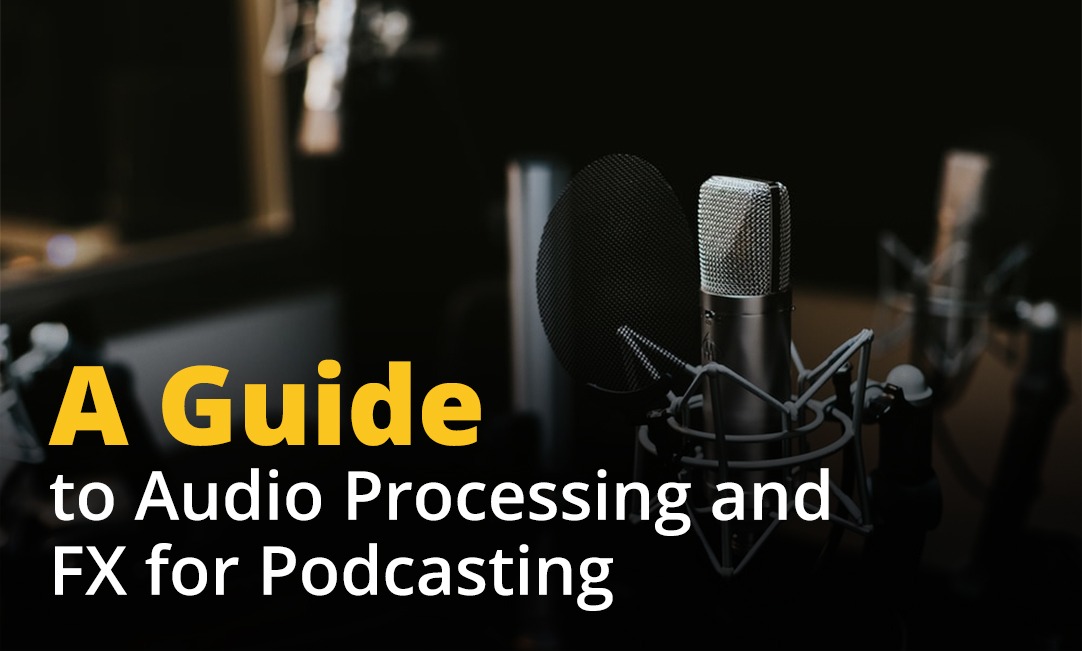A Guide to Audio Processing and FX for Podcasting

The sound quality of your podcast can either make a show or break it. Though you may have a gripping story, a thoroughly researched topic, presentation to have a great podcast, you must work on the sound quality. Undeniably, your recording space, microphones, preamps, mixers, interfaces, etc. are the basics of a great podcast however, audio processing and effects give your podcast an edge over others. Here, let’s focus on audio processing and effects on podcasts.
1. EQ or Equalization
Equalization, an important step in mixing all kinds of audio for all kinds of mediums, is the process of boosting or cutting the volume of certain frequencies in an audio signal. This is primarily done to manipulate the overall tone of a recording.
When we produce sound, it is made up of different frequencies. By adjusting EQ, you can boost or cut down the frequencies to get a perfect tone. You can achieve this by following simple rules and steadfast rules and the right type of EQ.
Equalizers are available in different formats. You can have it in the form of software installed in your Digital Audio Workstation; knobs on your mixer; switch on your microphone, guitars, guitar amps, sound system, and many more audio devices.
Most of these equalizers have three knobs for each channel – one for lows, mids and highs. Some come with just one or two. In professional studios, advanced consoles may have even more knobs. Turning the knob anticlockwise cuts down the frequency while turning it clockwise boosts it.
2. De-essing
While recording, sibilance poses problems. Therefore, they are required to curtail during recording. The process of reducing sibilance in a recording is termed De-essing. It can be done manually or using De-essers. However, De-essing manually is a time-consuming task and is not viable for the everyday podcaster. De-essers make your task easier. It is a processing tool that eliminates the harsh frequencies creating sibilance.
De-essers are available in the market in the form of plug-ins, hardware formats, and channel strips. Many DAWs also come with a ready-to-use de-esser.
De-essers work by reducing the volume of a certain frequency when it is detected. Depending on the type of de-essers, you can control parameters such as the cut-off frequency, how much the frequency is cut, how much gain can pass through before the de-esser is triggered, the speed at which the de-esser is triggered, and more.
3. Compression
Compression is a process in audio production to reduce the dynamic range of an audio signal by reducing the loudest parts and boosting the softest parts. The process makes a recording sound clearer, louder, and more natural without adding distortion. When you track speech for a podcast, adding compression makes the recording sound punchy, polished, and professional.
However, care should be taken during compressing sound for a podcast. Overdoing can ruin a recording. It can make a voice sound lifeless and unnatural. To control sound during recording, there are some adjustable parameters such as threshold, ratio, input level, output gain, attack, release, and knees.
4. Noise gate
Podcasting is easy and you can do it with the most basic gears. However, you may not have an ideal working space devoid of all unwanted noise. Similar to compressors and de-essers, a noise gate is a dynamic processor that controls the amount of an audio signal based on the recorded volume. It is used to remove unwanted noise in a recording by setting a gain threshold. The threshold acts as a gate that allows only audio signals, which are set above the threshold. For example, if you set the threshold at 45dB sounds louder than this would be allowed.
To control the background noise, it has several parameters that can be adjusted as per your needs. These are threshold, release, attack, hold, and range.
5. Ducking
Ducking is a sound effect that is used in all kinds of audio production and involves sidechain compression. This is a useful tool during an interview to ensure the host’s voice remains always more present than the guest’s.
Setting up ducking is a complex process that involves placing a noise gate on the channels you want to duck while feeding it at the gate of the track that you want to control.
Conclusion
All the audio processing and effects help in getting controlled audio signals that make your podcast sound better. UNION Recording Studio is a well-equipped professional recording studio that helps you in various audio processing and effects for your podcasts. To know more, visit our official site.